Free Transport To Save Animals' Lives
Kathleen Quinn Charleston, Pilots N Paws
 Over 3,000 volunteer pilots fly 250-mile jaunts to bring adoptive animals to new homes or shelters. This non-profit agency regularly moves animals from dogs and cats to donkeys, all at no charge. Kathleen Quinn Charleston, Executive Director, explains the Pilots N Paws' mission.
Over 3,000 volunteer pilots fly 250-mile jaunts to bring adoptive animals to new homes or shelters. This non-profit agency regularly moves animals from dogs and cats to donkeys, all at no charge. Kathleen Quinn Charleston, Executive Director, explains the Pilots N Paws' mission.
Pilots N Paws was founded in 2008 by animal-lover Debi Boies and pilot Jon Wehrenberg. The idea first took flight when Jon agreed to help Debi by flying a rescued Doberman from Florida to South Carolina, to save the dog's life. The trip was a success and the two brainstormed on how to rescue other animals. Spay/Neuter campaigns in parts of the country were working, while in others parts, primarily in the south, pet overpopulation was still a huge problem. There had to be a way to turn a problem into a solution. Former pets were dying needlessly. They needed transport out of there.
The great thing about plane transport is that pilots can cover longer distances a lot faster. Most pilots fly an average of 250 miles each. So if there is a transport of around 800 miles, there will be a relay of around 3 pilots to complete the transport. If the transport were being done by car, it could take 10-12 drivers, all driving one-hour increments, because they of course have to turn around and make their way back home. This leaves a lot of room for error in having to rely on so many people. Plus, these animals are already stressed; so flying reduces the number of people that they have to deal with.
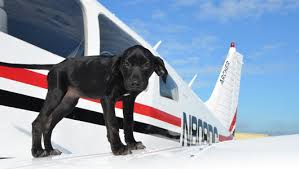 Most of the animals transported are rescues and they are usually coming from a kill type of situation (shelters that kill because of over-population). The animals may be transported to a no-kill shelter or even directly to an adoptive family.
Most of the animals transported are rescues and they are usually coming from a kill type of situation (shelters that kill because of over-population). The animals may be transported to a no-kill shelter or even directly to an adoptive family.
While most people think Pilots N Paws only transport dogs, the also fly cats, guinea pigs and boa constrictors, anything that needs to be rescued. Their strangest transport was when a pilot transported two small donkeys, but they had to turn down a request to fly a Lion, because they didn't have a plane big enough. They also transport service animals and working military dogs.
Pilots N Paws currently has over 4,200 volunteer pilots and they now fly more than 15,000 rescue animals each year, with volunteers in all 50 states. This unfortunately is not cheap. If you are a pilot and would like to help, or if you would like to make a donation, please visit their website.
http://www.pilotsnpaws.org
How To Tell If Your Pet's In Pain
Dr. Annie Forslund, Home Pet Euthanasia of Southern California
 Dogs and cats generally don't exhibit pain. This is a trait designed mostly to protect them in the wild. However, research now shows that when they are alone in a room they do show signs of pain, until someone enters the room. Dr. Annie Forslund tells us how to recognize pain in our pets.
Dogs and cats generally don't exhibit pain. This is a trait designed mostly to protect them in the wild. However, research now shows that when they are alone in a room they do show signs of pain, until someone enters the room. Dr. Annie Forslund tells us how to recognize pain in our pets.
Dr. Forslund explains that it's not that pet owners are mean or that they don't take care of their pets, its just because they don't know how tell if their animal is in pain. A pet is not going to cry, moan or whine, unless it's pretty unbearable.
No one knows why pets don't cry out in pain, but in Dr. Forslund's estimation, she believes it is a survival mechanism and they are built tough. In the wild, if they display any sign or weakness or pain, they set themselves up to a predator or for their own pack leader, who will end things very quickly. This is just nature's way of being kind so that the suffering is not prolonged.
However, in domesticated pets, we provide them with shelter and food as well as medical care, which is fine, but in an already tough species, it prolongs their suffering if their pain is not controlled properly.
It is very important to recognize little signs that will tell you if your pet's in pain. Dr. Forslund fills us in on some of the signs she suggests to look out for:
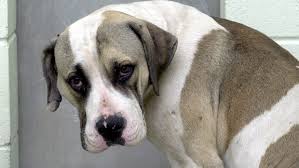 - drooping head or ears
- drooping head or ears
- lack of appetite
- neglecting treats
- disinterest in favorite toy
- tucked tail
- eye whites show prominently (caused by facial tension)
- frequent shifting when resting and waking up at night
- pacing
- trembling
- compulsive licking of a body part
- isolation and lack of interest in surroundings
Dr. Forslund tells us of a very interesting study that was done on pets that recently underwent a spay surgery. While a spay appears to be a very routine and mild surgery, it is an abdominal surgery and is actually a major surgery. Dr. Forslund tells us when she was in school many years ago, they were not told to use pain medication on a post-op for a routine surgery. It was felt at that time that animals did not feel pain like humans do, but we now know they do. The healing process can also be delayed if pain is not controlled.
For the study, they put a group of animals that had recently been spayed in rooms with cameras so they could be observed. These animals showed some signs of pain, such as a droopy head and ears, the pet might be seen licking the surgical area, or their head was downcast to possibly protect the painful surgery area. However, the moment that a caretaker entered the room, the pet instantly changed their attitude and acted like there was nothing wrong at all. Their tail started wagging and they greeted the caretaker. All of a sudden, all signs of pain were gone.
Dr. Forslund graduated from the University of Montreal in 1990. She moved to California in 1996 and while practicing veterinary Medicine she trained as a grief counselor and acquired 14 years of experience in that field. Seeking to combine her two major passions and utilizing her special connection with animals, she created Home Pet Euthanasia of Southern California and dedicated her practice to helping families faced with the very difficult time that the loss of a pet brings.
http://www.homepeteuthanasia.com
Protect Your Small Pet From Attacks
Johnny Dumas, Spike Bite
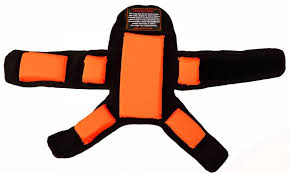 The "Spike Bite Pet Protector" is a new lightweight vest for your pet that can stop an attack from another animal instantly. There are an estimated 4.5 million dog bites each year to humans and an estimated 1 million attacks on pets from other animals. Smaller dogs are the prime target from a larger dog or dogs attack each other for dominance and territory.
The "Spike Bite Pet Protector" is a new lightweight vest for your pet that can stop an attack from another animal instantly. There are an estimated 4.5 million dog bites each year to humans and an estimated 1 million attacks on pets from other animals. Smaller dogs are the prime target from a larger dog or dogs attack each other for dominance and territory.
Smaller dogs are also at a greater risk for attacks from coyotes, wild cats, and of course larger dogs if they are in the wrong place at the wrong time. Many people have had their pets killed from wild animals and they wished they would have had a way to protect their pet. Losing a pet is almost like losing a child or a loved one for millions of people in today's world.
So how did Johnny come up with this idea? He lives in an area where there are many coyote attacks. He states these coyotes are a hybrid species, mixed with a grey wolf 20 years ago, creating a species that is capable of hopping a 17-foot tall fence. Lately, they have been hopping into yards and taking pets.
One day Johnny was planning to take his small dog out for a walk, when his mother asked what he would do in case of an attack? Johnny replied, "I will make him a porcupine vest!" As soon as the words came out of his mouth, Johnny knew he was on to something.
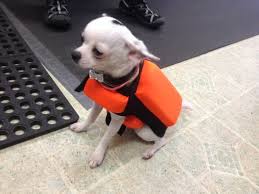 When Johnny went to look for a product such as this, he couldn't find anything that would protect his small dog. So, he invented the Spike Bite Pet Protector.
When Johnny went to look for a product such as this, he couldn't find anything that would protect his small dog. So, he invented the Spike Bite Pet Protector.
The key to the Spike Bite vest is that it has firm foam pads that are in a bright or florescent color (so you will know where the spikes are) and inside the foam pad there is a bed of spikes that are pointed into a blunt point. The foam pads are positioned in the most vulnerable areas for maximum protection. A pet owner may pick up their pet and hold them easily and does not have to worry about poking themselves with the spikes. It is also fluorescent to reflect the light at night.
The vest covers the most vital areas like the jugular, the ribs, back and stomach. Don't worry; your pet will not be walking around with spikes all over his body! It also only weighs 6 ounces, so it won't weigh down your dog.
When an animal attacks the pet, the attacker will bite into the foam pads. When the mouth bite presses down, the spikes attack the mouth of the animal. This stops an attack immediately and can save the pet's life in many cases. It also provides an opportunity for the pet to escape and for the owner to help save their pet.
http://www.spikebite.com
 The Dogfather's Grooming Tip with Joey Villani
The Dogfather's Grooming Tip with Joey Villani
Cat Stud Tail
What is Stud Tail? It's an over secretion of the sebaceous glands, mostly on young male cats.
If you've ever watched an un-neutered male cat, they will rub up against items. This could be your couch or the corner of your walls with their face, chin and even their tail. By doing this, they are marking their territory with the oils that come out of the sebaceous glands.
This sebaceous gland frequently over-secretes leaving a pretty pungent, disgusting smell. It will even leave your cat looking greasy. This normally happens at the base of their tail. You will usually see blackheads and hair loss in that area.
To cure it, your cat needs to make a visit to the veterinarian. But, you can keep it under control and make it look and smell better. To do this, go out and get a waterless hand cleanser, a degreaser, something that car mechanics frequently use. Heat it slightly in a microwave. Don't make it hot, you just want to slightly liquefy it.
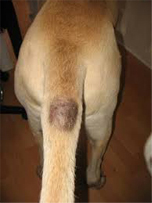 Take this mixture and work it into the area on the tail by using a small brush. Next, rinse it off really well to make sure you don't leave anything behind. Next, you will wash the area with regular shampoo. You will know if you still have traces of the cleanser, as the shampoo wont' lather real well, so make sure the cleanser is well rinsed before shampooing. After shampooing, dry the area.
Take this mixture and work it into the area on the tail by using a small brush. Next, rinse it off really well to make sure you don't leave anything behind. Next, you will wash the area with regular shampoo. You will know if you still have traces of the cleanser, as the shampoo wont' lather real well, so make sure the cleanser is well rinsed before shampooing. After shampooing, dry the area.
When you are all done, powder it with a little cornstarch. This will remove any grease or oil that is remaining.
If you stay on top of it by using the cornstarch two to three times a week, you won't have to do the whole de-greasing process and shampooing very often. If you don't stay on top of it, you will have to do the whole de-greasing, shampoo process weekly until your veterinarian cures the problem.
In most cases, if you get your male cat neutered, it will go away and not return.
Animal Radio® News with Judy Francis
Stores Stop Selling Chinese Made Treats
A few weeks ago we talked about dogs and cats getting sick after eating treats made in China, but despite years of testing, federal authorities haven't been able to figure out what it was in the treats that's causing the problem. The FDA says the treats have been linked to reports of over 5,000 cats and dogs getting sick and over 1,000 dogs dying. Now, both Petco and PetSmart say they aren't going to wait to find out what's wrong, they're going to stop selling Chinese-made treats. Since the reports began, both chains have been cutting down on Chinese-made treats and both say they'll now expand their line of American-made products along with treats made in New Zealand, Australia and South America.
 Find The Right Pet Match With Your Smart Phone
Find The Right Pet Match With Your Smart Phone
Finding just the right pet might be as easy as going to your smart phone. Superfish is a Palo Alto-based startup that specializes in image search. It's now created an app called PetMatch that lets you look for adoptable pets in your area based on photo technology. Here's how it works: you upload a picture of the pet you wish you could find; it might be a dog you see at the park; or maybe you want a cat just like one you used to have. If you don't have a photo, you can choose a picture from the app's internal library. PetMatch then does an image recognition search of similar, adoptable pets in your area and gives you the info to connect with the shelter or rescue that has them.
What Type of Pest Control Do You Choose For Your Pets?
Now that the weather is getting warmer, you have to start worrying about fleas, ticks and mosquitoes feasting on your pets. There are plenty of products out there. So how do you choose? An online survey sent to newsletter subscribers of dogchannel.com asked 2,700 dog owners whether they preferred using a topical product that kill pests through contact or oral treats that only kill fleas and ticks after they bite the animal. Overwhelmingly, dog owners gave topical treatments the thumbs up. In fact, 84-percent said they use them over the oral products. The survey was part of dogchannel.com's "Why Wait for the Bite?" campaign.
 Albino Dogs
Albino Dogs
Scientists keep on finding ways that animals and humans are more alike than different. The latest, that certain dogs, just like certain people, carry a gene mutation that results in little or no pigment to the eyes, skin and hair. Researchers at Michigan State University found that Albino Doberman's share the exact genetic mutation as people with albinism. And just like people with the condition who have a high sensitivity to sunlight, canines with the mutated genes also have a higher risk of developing skin tumors, much more than normal white dogs.
Dog Bites Reach Epidemic Proportions
You've probably seen that amazing video on YouTube of the family cat saving a 4-year-old boy from an attack by a neighborhood dog. Turns out, the American Humane Association says that the dog bite situation is at epidemic proportions. Every year, over 4.5-million Americans are bitten by dogs. More than half of them are children. And these bites aren't always coming from the type of dogs you might think. Even a small, mild-mannered pooch can bite. What's the solution? The Association says better education and awareness among dog owners and the public, along with better-trained dogs.
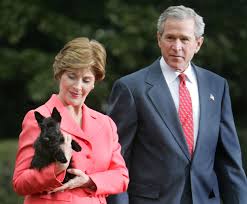 One Of The Nations First Dogs From Earlier Presidency Passes
One Of The Nations First Dogs From Earlier Presidency Passes
The Nation's 'First Dog' from George W. Bush's Presidency has died. Miss Beazley lost her battle with cancer and was recently put to sleep. The black Scottish terrier was nearly 10 years old. She was presented to First Lady Laura Bush by her husband as a birthday present. Miss Beazley was featured in a December 2005 video, "A Very Beazley Christmas," a look at White House holiday life presented from a dog's point of view. She was named for the character Uncle Beazley, a dinosaur in Oliver Butterworth's children's book, "The Enormous Egg."
Are Our Dogs Opinionated?
Our pets watch everything we do, but do they have an opinion on it? That's the gist of a new short from first-time director Patrick Osborne and Walt Disney Animation Studios. Feast is making its world premiere at the Annecy International Film Festival. It's the story of one man's love life as seen through the eyes of his best friend and dog, Winston, and told bite by bite through the meals that they share. It will open in theaters in front of Disney's big-screen adventure "Big Hero 6" in November.

NEWS UPDATE brought to you by Drs. Foster & Smith, affordable pet supplies. Low prices every day, so you save on every order.
 Listen to the entire Podcast of this show (#757)
Listen to the entire Podcast of this show (#757)



 Over 3,000 volunteer pilots fly 250-mile jaunts to bring adoptive animals to new homes or shelters. This non-profit agency regularly moves animals from dogs and cats to donkeys, all at no charge. Kathleen Quinn Charleston, Executive Director, explains the Pilots N Paws' mission.
Over 3,000 volunteer pilots fly 250-mile jaunts to bring adoptive animals to new homes or shelters. This non-profit agency regularly moves animals from dogs and cats to donkeys, all at no charge. Kathleen Quinn Charleston, Executive Director, explains the Pilots N Paws' mission. Dogs and cats generally don't exhibit pain. This is a trait designed mostly to protect them in the wild. However, research now shows that when they are alone in a room they do show signs of pain, until someone enters the room. Dr. Annie Forslund tells us how to recognize pain in our pets.
Dogs and cats generally don't exhibit pain. This is a trait designed mostly to protect them in the wild. However, research now shows that when they are alone in a room they do show signs of pain, until someone enters the room. Dr. Annie Forslund tells us how to recognize pain in our pets. When Johnny went to look for a product such as this, he couldn't find anything that would protect his small dog. So, he invented the Spike Bite Pet Protector.
When Johnny went to look for a product such as this, he couldn't find anything that would protect his small dog. So, he invented the Spike Bite Pet Protector. The Dogfather's Grooming Tip with
The Dogfather's Grooming Tip with  Take this mixture and work it into the area on the tail by using a small brush. Next, rinse it off really well to make sure you don't leave anything behind. Next, you will wash the area with regular shampoo. You will know if you still have traces of the cleanser, as the shampoo wont' lather real well, so make sure the cleanser is well rinsed before shampooing. After shampooing, dry the area.
Take this mixture and work it into the area on the tail by using a small brush. Next, rinse it off really well to make sure you don't leave anything behind. Next, you will wash the area with regular shampoo. You will know if you still have traces of the cleanser, as the shampoo wont' lather real well, so make sure the cleanser is well rinsed before shampooing. After shampooing, dry the area. Find The Right Pet Match With Your Smart Phone
Find The Right Pet Match With Your Smart Phone
 Albino Dogs
Albino Dogs
 One Of The Nations First Dogs From Earlier Presidency Passes
One Of The Nations First Dogs From Earlier Presidency Passes
